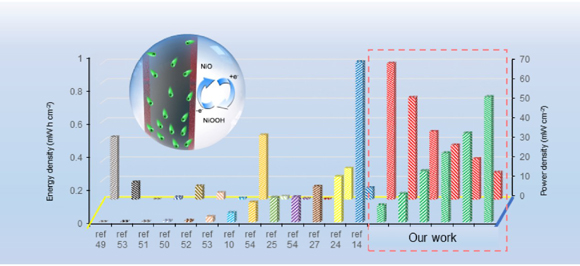Researchers from School of Chemistry developed Nickel@Nickel Oxide Core–Shell Electrode for Ultrahigh‐Energy and Stable Aqueous Ni–Zn Battery
Source: School of Chemistry
Written by: School of Chemistry
Edited by: Wang Dongmei
To pursue the increasing demands for wearable and portable devices, as well as severe concerns of energy and climate crisis, renewable energies have attracted extensive interest in efficient energy conversion and storage devices. Compared with traditional lithium-ion batteries, aqueous rechargeable batteries have attracted tremendous attention for renewable energy conversion and storage owing to their good safety, low cost, enhanced rate performance, and high ionic conductivity. Of various types of aqueous rechargeable batteries, the nickel-zinc battery is expected as a promising alternative to the lithium-ion battery because of their merits of high safety, abundant resource, the high output voltage (≈1.8 V) as compared to that of other aqueous batteries (mostly ≤1.2 V). Currently, one of the most bottlenecks for Ni-Zn batteries is the relatively low capacity of the Ni-based cathode, which restricts the development of nickel-zinc batteries. Thus, to design and develop a novel high-energy aqueous nickel-zinc battery is highly challenging and pursued.

The energy density and power density of nickel-zinc battery with Ni@NiO cathode
Recently, Professor Xihong Lu and Professor Jiuxing Jiang from the School of Chemistry at Sun Yat-sen University have developed a kind of Ni@NiO core-shell cathode for a high-energy and stable aqueous rechargeable Ni-Zn battery. Compared with blank nickel foam, the Ni@NiO core-shell cathode shows remarkably boosted reactivity, larger specific area and fast interfacial charge transfer and ion transport. As a consequence, the nickel-zinc battery based on Ni@NiO cathode achieves an impressive energy density of 15.1 mW h cm−3and a peak power density of 1392 mW cm−3, outperforming most reported aqueous rechargeable energy-storage devices. And the Ni@NiO cathode can be prepared on a large scale and present excellent cycling stability. Moreover, the assembled nickel-zinc battery has impressive compressibility, and it shows no capacity attenuation after being compressed.
This work has been published in Advanced Functional Materials. (Rui Wang, Yi Han, Zifan Wang, Jiuxing Jiang*, Yexiang Tong and Xihong Lu* Adv. Funct. Mater., 2018, 28, 1802157). The title is “Nickel@Nickel Oxide Core-Shell Electrode with Significantly Boosted Reactivity for Ultrahigh-Energy and Stable Aqueous Ni–Zn Battery”. The authors acknowledge the financial support of the National Natural Science Foundation of China, Guangdong Natural Science Funds for Distinguished Young Scholar, National Key R&D Program of China, Tip-top Scientific and Technical Innovative Youth Talents of Guangdong Special Support Program, Pearl River Nova Program of Guangzhou and so on.
Link to the article: https://onlinelibrary.wiley.com/doi/epdf/10.1002/adfm.201802157
